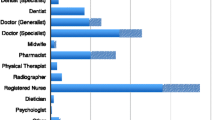Abstract
This chapter describes the push, pull, stick and stay factors for the MoHProf countries. Many of the aspects reported here will also appear elsewhere in this report. It is thought to be of importance, though, to provide a systematic overview of the factors reported by the country teams in their overviews of these factors. However, one should recognise that out- or in-migration occurs as a consequence of a conglomerate of personal, social, professional, sectoral and societal specificities, as will be discussed in the following paragraphs. Highly individual decisions may, taken together, lead to migratory waves.
Access this chapter
Tax calculation will be finalised at checkout
Purchases are for personal use only
Similar content being viewed by others
Notes
- 1.
Of the 1567 foreign health workers an additional 15% come from Viet Nam, 10% from North Korea, and 19% from Russia. Nearly all (93%) of all these health workers entered Angola on basis of a bilateral agreement.
- 2.
The Irish report, on which this discussion is based, was written before consequences of the economic downturn impacted.
- 3.
In as far as this coincides with reduction of working hours. There are reasons to assume this is more related to other desires about work-life balances of younger doctors than older. See ▶ Chap. 2.
- 4.
That is, before the most recent changes.
- 5.
This may, in fact, be a multi-layered remark. Not only can it be that remittances are required to pay off debts to recruiters, the remittances may also play a vital role in the family economy, for instance in paying off study debts, but also to keep the family thriving. Lastly, the level of remittances may be so high as to oblige the migrants to live in below-standard circumstances and doing many extra hours, driven by the obligation to support their family while possibly surprised by the cost of living in the receiving countries, and thus, not even being able to return.
Author information
Authors and Affiliations
Corresponding author
Editor information
Editors and Affiliations
Rights and permissions
Copyright information
© 2013 Springer-Verlag Berlin Heidelberg
About this chapter
Cite this chapter
Tjadens, F., Eckert, J., Weilandt, C. (2013). Factors contributing to mobility of health workers. In: Mobility of Health Professionals. Springer, Berlin, Heidelberg. https://doi.org/10.1007/978-3-642-34053-6_3
Download citation
DOI: https://doi.org/10.1007/978-3-642-34053-6_3
Published:
Publisher Name: Springer, Berlin, Heidelberg
Print ISBN: 978-3-642-34052-9
Online ISBN: 978-3-642-34053-6
eBook Packages: MedicineMedicine (R0)




